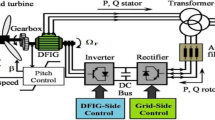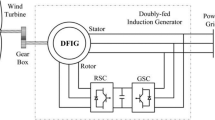Abstract
This paper proposes a fractional-order adaptive backstepping control (FOABC) with disturbance and uncertainty terms compensation for improving the MPPT (maximum power point tracking) performance and output power quality of a doubly fed induction generator (DFIG)-based wind turbine. In the proposed high-efficacy controller, disturbance and uncertainty terms are estimated in real time using an adaptive estimator designed using a recursion design process based on the nonlinear backstepping control. Meanwhile, a robust compensator is schemed and incorporated into the backstepping control algorithm so that it suppresses the effects of external disturbances and system uncertainties and, as a result, ensures the maximum wind energy extraction as much as possible, which is usually well known as MPPT. Furthermore, the fractional-order control approach was deployed in the proposed adaptive backstepping controller to provide a smooth control signal for enhancing the quality of the power injected into the grid. The stability analysis of the overall closed-loop system was performed using Lyapunov's stability theory. The high effectiveness of the proposed control method was assessed through simulation studies carried out in MATLAB/Simulink of a DFIG-wind turbine operating in various conditions.












Similar content being viewed by others
Abbreviations
- FOABC:
-
Fractional-order adaptive backstepping control
- DFIG:
-
Doubly fed induction generator
- MPPT:
-
Maximum power point tracking
- PI:
-
Proportional-integral
- LCF:
-
Lyapunov candidate functions
- RSC:
-
Rotor side converter
- PWM:
-
Pulse width modulation
- TSR:
-
Tip speed ratio
- SFOC:
-
Stator flux orientation control
- FO:
-
Fractional-order
- CBC:
-
Classical backstepping controller
- FFT:
-
Fast Fourier transform
- THD:
-
Total harmonic distortion
References
Patel, R.; Hafiz, F.; Swain, A.; Ukil, A.: Nonlinear rotor side converter control of DFIG based wind energy system. Electr. Power Syst. Res. 198, 107358 (2021). https://doi.org/10.1016/j.epsr.2021.107358
Rocha-Osorio, C.M.; Solís-Chaves, J.S.; Rodrigues, L.L.; Puma, J.A.; Sguarezi Filho, A.J.: Deadbeat–fuzzy controller for the power control of a Doubly Fed Induction Generator based wind power system. ISA Trans. 88, 258–267 (2019). https://doi.org/10.1016/j.isatra.2018.11.038
Xiong, P.; Sun, D.: Backstepping-based DPC strategy of a wind turbine-driven DFIG under normal and harmonic grid voltage. IEEE Trans. Power Electron. 31(6), 4216–4225 (2015). https://doi.org/10.1109/TPEL.2015.2477442
Khedher, A.; Khemiri, N.; Mimouni, M.F.: Wind energy conversion system using DFIG controlled by backstepping and sliding mode strategies. Int. J. Renew. Energy Res. 2(3), 421–430 (2012). https://doi.org/10.20508/ijrer.v2i3.249.g6040
Omeje, C.O.; Nnadi, D.B.; Odeh, C.I.: Theory and modeling of a 150KW doubly fed induction machine with bidirectional multi-level converters control using SVPWM technique. Arab. J. Sci. Eng. 39(8), 6339–6349 (2014). https://doi.org/10.1007/s13369-014-1275-4
Bounadja, E.; Djahbar, A.; Boudjema, Z.: Variable structure control of a doubly fed induction generator for wind energy conversion systems. Energy Procedia 50, 999–1007 (2014). https://doi.org/10.1016/j.egypro.2014.06.119
Sivakumar, T.A.; Linda, M.M.: Improving the dynamic performance of grid connected wind farms using modern UPFC. Microprocess. Microsyst. 74, 103015 (2020). https://doi.org/10.1016/j.micpro.2020.103015
Roy, T. K.; Mahmud. M. A.; & Oo A. M. T.: Nonlinear backstepping controller design for improving fault ride through capabilities of DFIG-based wind farms. In: 2018 IEEE Power & Energy Society General Meeting (PESGM). IEEE, 2018. p 1–5. Doi: https://doi.org/10.1109/PESGM.2018.8586580
Seixas, M.; Melício, R.; Mendes, V.M.F.: Offshore wind turbine simulation: Multibody drive train. Back-to-back NPC (neutral point clamped) converters. Fractional-order control. Energy 69, 357–369 (2014). https://doi.org/10.1016/j.energy.2014.03.025
Zeghdi, Z.; Barazane, L.; Bekakra, Y.; Larabi, A.: Improved backstepping control of a DFIG based wind energy conversion system using ant lion optimizer algorithm. Period. Polytech. Electr. Eng. Comput. Sci. 66(1), 43–59 (2022). https://doi.org/10.3311/PPee.18716
Li, S.H.; Haskew, T.A.; Williams, K.A.; Swatloski, R.P.: Control of DFIG wind turbine with direct-current vector control configuration. IEEE Trans. Sustain. Energy 3(1), 1–11 (2012)
Benaama, K.; Khiat, M.; Barkat, S.: Real time modeling and control of a wind farm connected to a multi-bus network under faulty conditions. ISA Trans. 93, 384–398 (2019). https://doi.org/10.1016/j.isatra.2019.03.013
Kerrouche, K.; Mezouar, A.; Belgacem, K.: Decoupled control of doubly fed induction generator by vector control for wind energy conversion system. Energy Proc. 42, 239–248 (2013). https://doi.org/10.1016/j.egypro.2013.11.024
Benamor, A.; Benchouia, M.T.; Srairi, K.; Benbouzid, M.E.H.: A new rooted tree optimization algorithm for indirect power control of wind turbine based on a doubly-fed induction generator. ISA Trans. 88, 296–306 (2019). https://doi.org/10.1016/j.isatra.2018.11.023
Balcazar, R.; Rubio, J.D.J.; Orozco, E., et al.: The regulation of an electric oven and an inverted pendulum. Symmetry. 14(4), 759 (2022). https://doi.org/10.3390/sym14040759
Villaseñor Rios, C.A.; Luviano-Juárez, A.; Lozada-Castillo, N.B., et al.: Flatness-based active disturbance rejection control for a PVTOL aircraft system with an inverted pendular load. Machines 10(7), 595 (2022). https://doi.org/10.3390/machines10070595
Silva-Ortigoza, R.; Hernández-Márquez, E.; Roldán-Caballero, A., et al.: Sensorless tracking control for a “full-bridge buck inverter–dc motor” system: passivity and flatness-based design. IEEE Access. 9, 132191–132204 (2021). https://doi.org/10.1109/ACCESS.2021.3112575
Kasbi, A.; Rahali, A.: Performance optimization of doubly-fed induction generator (DFIG) equipped variable-speed wind energy turbines by using three-level converter with adaptive fuzzy PI control system. Mater. Today Proc. 47, 2648–2656 (2021). https://doi.org/10.1016/j.matpr.2021.05.406
Nadour, M.; Essadki, A.; Nasser, T.: Comparative analysis between PI & backstepping control strategies of DFIG driven by wind turbine. Int. J. Renew. Energy Res. 7(3), 1307–1316 (2017). https://doi.org/10.20508/ijrer.v7i3.6066.g7163
Kammoun, S.; Sallem, S.; Kammoun, M.B.A.: Backstepping control for low-voltage ride through enhancement of DFIG-based wind turbines. Arab. J. Sci. Eng. 42(12), 5083–5099 (2017). https://doi.org/10.1007/s13369-017-2606-z
Parvaresh, A.; Abrazeh, S.; Mohseni, S.R.; Zeitouni, M.J.; Gheisarnejad, M.; Khooban, M.H.: A novel deep learning backstepping controller-based digital twins technology for pitch angle control of variable speed wind turbine. Designs 4(2), 15 (2020). https://doi.org/10.3390/designs4020015
Mechter, A.; Kemih, K.; Ghanes, M.: Backstepping control of a wind turbine for low wind speeds. Nonlinear Dyn. 84(4), 2435–2445 (2016). https://doi.org/10.1007/s11071-016-2655-y
Nemmour, A.L.; Mehazzem, F.; Khezzar, A.; Hacil, M.; Louze, L.; Abdessemed, R.: Advanced backstepping controller for induction generator using multi-scalar machine model for wind power purposes. Renew. Energy 35(10), 2375–2380 (2010). https://doi.org/10.1016/j.renene.2010.02.016
Zhang, Z.Z.; Zou, J.X.; Zheng, G.; Xu, H.B.: Observer-based backstepping control of the half-direct permanent magnet wind power generation system. Proc. Inst. Mech. Eng. Part I: J. Syst. Control Eng. 226(4), 441–450 (2012). https://doi.org/10.1177/0959651811426228
Trabelsi, R.; Khedher, A.; Mimouni, M.F.; M’sahli, F.: Backstepping control for an induction motor using an adaptive sliding rotor-flux observer. Electr. Power Syst. Res. 93, 1–15 (2012). https://doi.org/10.1016/j.epsr.2012.06.004
Roy, T.K.; Mahmud, M.A.; Oo, A.M.: Robust adaptive backstepping excitation controller design for higher-order models of synchronous generators in multimachine power systems. IEEE Trans. Power Syst. 34(1), 40–51 (2018). https://doi.org/10.1109/TPWRS.2018.2868783
Yin, W.; Wu, X.; Rui, X.: Adaptive robust backstepping control of the speed regulating differential mechanism for wind turbines. IEEE Trans. Sustain. Energy 10(3), 1311–1318 (2018). https://doi.org/10.1109/TSTE.2018.2865631
Adekanle, O.S.; Guisser, M.; Abdelmounim, E.; Aboulfatah, M.: Observer-based adaptive backstepping control of grid-connected wind turbine under deep grid voltage dip. In: Recent Advances in Electrical and Information Technologies for Sustainable Development, pp. 75–84. Springer, Cham (2019)
Wang, J.; Bo, D.; Ma, X.; Zhang, Y.; Li, Z.; Miao, Q.: Adaptive back-stepping control for a permanent magnet synchronous generator wind energy conversion system. Int. J. Hydrogen Energy 44(5), 3240–3249 (2019). https://doi.org/10.1016/j.ijhydene.2018.12.023
Kasbi, A.; Rahali, A.: Performance improvement of modern variable-velocity wind turbines technology based on the doubly-fed induction generator (DFIG). Mater. Today Proc. 45, 5426–5432 (2021). https://doi.org/10.1016/j.matpr.2021.02.114
Roy, T. K.; Mahmud, M. A.; Islam, S. N.; Oo, A. M.; & Muttaqi, K. M.: Enhancement of fault ride through capabilities for grid-connected DFIG-based wind farms using nonlinear adaptive backstepping controllers. In: 2018 IEEE International Conference on Power Electronics, Drives and Energy Systems (PEDES). IEEE. p. 1–6 (2018).
Kot, R.; Rolak, M.; Malinowski, M.: Comparison of maximum peak power tracking algorithms for a small wind turbine. Math. Comput. Simul. 91, 29–40 (2013). https://doi.org/10.1016/j.matcom.2013.03.010
Nasef, S.A.; Hassan, A.A.; Elsayed, H.T.; Zahran, M.B.; El-Shaer, M.K.; Abdelaziz, A.Y.: Optimal tuning of a new multi-input multi-output fuzzy controller for doubly fed induction generator-based wind energy conversion system. Arab. J. Sci. Eng. 47(3), 3001–3021 (2022). https://doi.org/10.1007/s13369-021-05946-4
Morawiec, M.; Blecharz, K.; Lewicki, A.: Sensorless rotor position estimation of doubly fed induction generator based on backstepping technique. IEEE Trans. Industr. Electron. 67(7), 5889–5899 (2019). https://doi.org/10.1109/TIE.2019.2955403
Kasbi, A.; Rahali, A.: Adaptive FOPI controller based on the fuzzy supervisory for wind power conversion system equipped by a doubly fed induction generator. Int. Trans. Electr. Energy Syst. 31(8), e12923 (2021). https://doi.org/10.1002/2050-7038.12923
Chen, S.Y.; Li, T.H.; Chang, C.H.: Intelligent fractional-order backstepping control for an ironless linear synchronous motor with uncertain nonlinear dynamics. ISA Trans. 89, 218–232 (2019). https://doi.org/10.1016/j.isatra.2018.12.036
Naidu, R.P.K.; Meikandasivam, S.: Power quality enhancement in a grid-connected hybrid system with coordinated PQ theory & fractional order PID controller in DPFC Sustainable. Sustain. Energy Grids Netw. 21, 100317 (2020). https://doi.org/10.1016/j.segan.2020.100317
Soomro, M.A.; Memon, Z.A.; Kumar, M.; Baloch, M.H.: Wind energy integration: dynamic modeling and control of DFIG based on super twisting fractional order terminal sliding mode controller. Energy Rep. 7, 6031–6043 (2021). https://doi.org/10.1016/j.egyr.2021.09.022
Asgharnia, A.; Shahnazi, R.; Jamali, A.: Performance and robustness of optimal fractional fuzzy PID controllers for pitch control of a wind turbine using chaotic optimization algorithms. ISA Trans. 79, 27–44 (2018). https://doi.org/10.1016/j.isatra.2018.04.016
Xiong, L.; Li, P.; Ma, M.; Wang, Z.; Wang, J.: Output power quality enhancement of PMSG with fractional order sliding mode control. Int. J. Electr. Power Energy Syst. 115, 105402 (2020). https://doi.org/10.1016/j.ijepes.2019.105402
Labbadi, M.; El Moussaoui, H.: An improved adaptive fractional-order fast integral terminal sliding mode control for distributed quadrotor. Math. Comput. Simul. 188, 120–134 (2021). https://doi.org/10.1016/j.matcom.2021.03.039
Mahvash, H.; Taher, S.A.; Rahimi, M.; Shahidehpour, M.: Enhancement of DFIG performance at high wind speed using fractional order PI controller in pitch compensation loop. Int. J. Electr. Power Energy Syst. 104, 259–268 (2019). https://doi.org/10.1016/j.ijepes.2018.07.009
Author information
Authors and Affiliations
Corresponding author
Rights and permissions
Springer Nature or its licensor (e.g. a society or other partner) holds exclusive rights to this article under a publishing agreement with the author(s) or other rightsholder(s); author self-archiving of the accepted manuscript version of this article is solely governed by the terms of such publishing agreement and applicable law.
About this article
Cite this article
Kasbi, A., Rahali, A. MPPT Performance and Power Quality Improvement by Using Fractional-Order Adaptive Backstepping Control of a DFIG-Based Wind Turbine with Disturbance and Uncertain Parameters. Arab J Sci Eng 48, 6595–6614 (2023). https://doi.org/10.1007/s13369-022-07474-1
Received:
Accepted:
Published:
Issue Date:
DOI: https://doi.org/10.1007/s13369-022-07474-1




